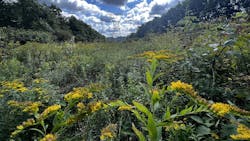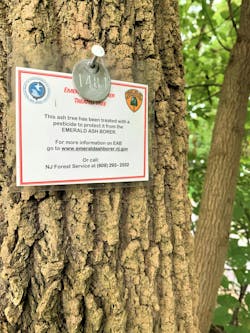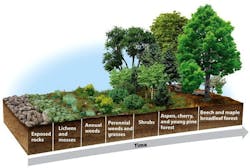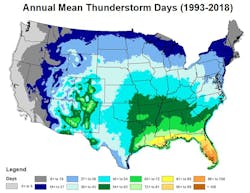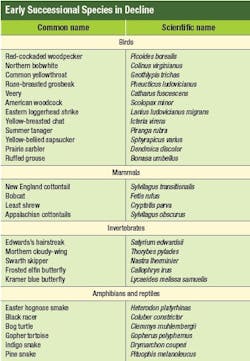Boosting Biodiversity in ROW Managed with IVM
Electric utilities nationwide face the challenges of climate change and natural ecosystem disturbances. Case in point: About 10,000 thunderstorms occur each year in the United States, according to the National Weather Service. Additionally, paleoclimatologists have found evidence of hurricanes impacting North America thousands of years in the past. These scientists study clues in earth’s geologic history through core samples taken from coastal areas where tropical storms and cyclones strike.
This type of severe weather has consistently contributed to massive disturbances of the status quo ecosystem where they occurred. In pre-human history in North America, thunderstorms and fire went hand in hand shaping the Great Plains, according to the National Park Service. By examining coastal core samples, paleotempestologists are finding charcoal layers immediately after sand layers. This indicates that after major hurricanes strike, the toppled trees and brush burned, drastically altering the existing ecosystem, according to AmericanScientist.org.
“The pollen above the sand layers also shows that following these hurricanes, salt-tolerant plants increased in abundance, presumably because of an influx of saltwater from the storm surge. What’s more, we found indications that the local pines took considerable time to recover from the damage that storm and fire inflicted on them.”
Tracing the Ecological Progression
Following these disturbances, a clear ecological progression of plants and animals occurs. The severity of a disturbance dictates which plant species will be the first to take advantage of these new ecosystem conditions. The most extreme example would be a rock with bare ground. In that case, lichens and mosses would be the first to colonize, followed by annual weeds, perennial grasses and weeds, shrubs, trees like aspens and pine trees and finally the hardwood forest. All this would take hundreds if not thousands of years to reach the final climax forest.
All the while, in each stage of succession many different plants grow producing uncountable numbers of seeds. These seeds lie dormant in the soil waiting for correct conditions for germination, according to the Weed Science Society of America. If a disturbance occurs, for example, in the shrub phase of succession, the seeds of the annual weeds and perennial seeds would sprout arresting the ecological succession for a period of time until the shrubs can take back over. This cycle of disturbance has been occurring for millions of years according to geologists.
The geologic time scale is a concept that divides the earth’s age to describe the timing and relationships of events in geologic history. For example, during the Jurassic Era, dinosaurs ruled the Earth and the flora and fauna were much different than they are today. The dinosaurs’ reign ended with an asteroid impact some 66 million years ago, causing a mass extinction event for many other animals as well, which is an extreme example of an ecological disturbance.
Analyzing Humans’ Impact on the Environment
Now let’s fast forward through the many different eras between then and about 11,500 years ago, when the glacier ice melted away and the Earth entered the Holocene Epoch. This time period gave rise to modern humans, who built great civilizations and huge technological advancements. Scientists have debated that a new epoch started at the rise of the Industrial Revolution in the 1800s. It is dubbed the Anthropocene, meaning human (anthropo) and new (cene).
Although no clear consensus exists about when the Anthropocene started, it has been agreed upon that humans have had huge impacts on the environment, more so than any other species that existed prior. The human impact of biodiversity is one of the major markers of the Anthropocene. Most experts agree that humans have accelerated the rates of extinction. The exact rate remains up for debate, but ranges are estimated between 100 to 1,000 times the normal
background extinction rates.
According to the 2021 Economics of Biodiversity review, written by Partha Dasgupta and published by the UK government, “biodiversity is declining faster than at any time in human history” and is labeled as the sixth mass extinction event. A 2023 study published in Biological Reviews found some 48% of 70,000 monitored species are experiencing population declines from human activity, whereas only 3% have increasing populations.
The exact cause of this biodiversity loss is debated among scientists. Some credit human overpopulation and excessive consumption, others point to climate change and habitat destruction.
Additionally, with a global economy, the introduction of invasive species has had a significant impact on ecosystems. One such invasive insect that many utility vegetation managers are familiar with is the Emerald Ash Borer. This beetle has killed millions and millions of ash trees in North America causing drastic changes in forest cover types, particularly east of the Mississippi River. This is one such example of the human impact on biodiversity. Additionally, utilities have had to mitigate the dead ash trees that could potentially strike utility equipment causing damage and outages.
Making the Case for Biodiversity
A rise in human population leads to an increased need for housing, food, recreation space and essential utilities such as water and electricity. All these needs require an altering of the existing environment and can create fragmented ecosystems and lead to biodiversity decline. According to conservation.org, many reasons exist to maintain biodiversity, such as:
- Wildlife supports healthy ecosystems that we rely upon. Ecosystems provide fresh water, pollination, soil fertility and stability, food and medicine. Weakened ecosystems are less likely to deliver those services.
- Keeping biodiverse ecosystems intact helps humans stay healthy. Research indicates a close link between disease outbreaks and the degradation of nature. We have seen the damage that diseases can do not only to human health, but also to the global economy. By protecting biodiversity in Earth’s ecosystems, countries could save lives and money, while helping to prevent future pandemics.
- Biodiversity is an essential part of the solution to climate change. A group of researchers led by Bronson Griscom from Conservation International discovered that nature can deliver at least 30 percent of the emissions reductions needed by 2030 to prevent climate catastrophe. Protecting biodiversity plays a crucial part in achieving these emissions reductions.
- Biodiversity is good for the economy. At least 40 percent of the world’s economy and 80 percent of the needs of the poor are derived from biological resources. Up to 35 percent of the world’s food is pollinated by insects.
- Biodiversity is an integral part of culture and identity. Species are frequently integral to religious, cultural and national identities.Ecosystems such as parks and other protected areas also provide recreation and a knowledge resource for visitors, and biodiversity is a frequent source of inspiration for artists and designers.
Creating Early Successional Habitats
Through the loss of habitat, it becomes obvious that the opportunity for natural disturbances to create early successional habitat becomes less. This places strain on the insects and animals requiring these habitats to complete their life cycle.
Pollinators have been highlighted in recent years due to their decline and their importance to the food supply chain. The Center for Biological Diversity discovered that 24% of native bees are imperiled, and population declines are occurring in 52% of native bees. In addition to pollinators, according to America’s Longleaf Restoration Initiative, other early successional species are
on the decline.
Integrated Vegetation Management (IVM) techniques on rights of way (ROW) can create the critical early successional habitat necessary for a healthy ecosystem through promoting lower growing grasses, forbs and shrubs. Not only does this promote biodiverse areas and species-rich ecosystems but is compatible with vegetation management plans on electric utility ROW, according to “Powerline Right-of-Way Management and Flower-Visiting Insects: How vegetation management can promote pollinator diversity” by Laura RussoI, Hannah Stout, Dana Roberts, Bradley D. Ross and Carolyn G. Mahan. By creating a system of arrested successional development, IVM mimics those critical disturbances that many species rely upon.
Powerful weather events like thunderstorms, hurricanes and ice storms topple over trees and have historically created early successional biodiverse habitats that many species rely on to survive, including humans. As humans expand into previously undeveloped areas, they have tremendous opportunity to develop critical early successional, biodiverse habitats on utility ROW by using proven IVM techniques. As stewards of the lands that the utilities cross, we have a a certain responsibility to maximize the biodiversity potential.
About the Author
Stephen Hilbert
Manager, technical services, Asplundh Tree Experts, LLC
Stephen Hilbert ([email protected]) is a manager in the technical services department at Asplundh Tree Experts, LLC providing education and training to Asplundh’s field employees on utility vegetation management and is Asplundh’s voting member on the ANSI A300 Committee. He has a long-held passion for tree care.
